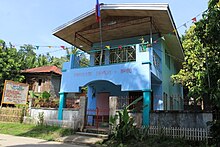Barangay
The Barangay ( rare Baranggay ), formerly known as the Barrio, is the lowest level in the administrative structure in the Philippines, the very a village or a town or district is similar in structure. Within the barangays there can still be sitios, this is about separate living spaces without administrative relevance.
Municipalities and cities are composed of individual barangays. There are a total of 42 026 barangays in the Philippines (as of 31 March 2011).
History
Originally, the word Barangay describes a relatively small community of 50 to 100 families. Most villages consist of 30 to 100 houses and have a population of 100 to 500 people.
The word itself is derived from an old name for a Malay boat, which was Balangay. This connection between community and boat supports some theories of pre-colonial history of the Philippines. They deal with the question of how the individual coastal barangays were created. For this purpose, given as a possibility that each of these coastal barangays has been founded by settlers who came by boat from other places in Southeast Asia.
Most settlements were established along the coasts and rivers of the islands, because here was given with fish and fruits a good food source. In addition, the people were moving mostly along or on the water from one place to the next. The fresh water of the rivers served the people as a drinking source for washing and bathing. Also, coastal settlements were more accessible for traders. Through the business relationship with merchants, the locals came with other cultures and civilizations in contact, such as the Chinese, the Indians and the Arabs with which these location zugutekam their economic development. To reach the coastal settlements in Manila, Iloilo, Panay, Cebu, Jolo, and Butuan a high cultural level.
After the arrival of the Spanish colonists different barangays were combined to form villages. Every barangay within a village was led by a Cabeza de barangay ( barangay chief ), which belonged to the upper class of the municipalities of the Spanish Philippines.
The Office was originally passed on from the first Datus, who held the position of Cabezas de Barangay, and later, after the end of the Spanish regency, the Office has been assigned by an election. The main task of the Cabeza de Barangay was the collection of taxes by the inhabitants of its area of responsibility.
After the colonial takeover of the Americans, the name Barrio won a different meaning than most barangays were provided with names. The term Barrio talked long into the 20th century until President Ferdinand Marcos issued an arrangement which replaced the designation by the term Barrio Barangay. Nevertheless, in the parlance for some people is still the old name Barrio present.
Administrative structure
Each barangay is headed by a chairman ( Punong Barangay Captain or Baranggay ). This passes the Barangay Council ( Ssangguniang Baranggay ), composed of 7 Barangay Councils ( Kagawad ). In addition, each barangay has a Youth Council ( " Sangguniang Kabataan " or "SK" ), which consists of the SK President or the Chairman of the SK Council. This leads youth-oriented activities in the barangay such as basketball clubs.
Altogether there are eight members of the Council, each of which derives its own area of responsibility. The areas are: (1) area for peace and order, (2) infrastructure, (3) education, (4 ) Health ( 5) Agriculture (6 ) tourism (7 ) Finance and ( 8) Sports and Youth. For each area, three members shall be appointed to support the work of the Chairman.
The structure is the same as with the provincial and local governments.
Liga ng mga Barangay
In the Philippines there for quite some time a union of barangays; ng mga Barangay league ( German: League of Barangays ). References relate mostly to their old name Association of Barangay Captains (ABC).
It represents all 42 026 barangays and is the largest grassroots organization in the Philippines.
Other Uses
The term barangay is also used as epithet of people. For example, wearing a sponsor of the basketball team, Ginebra San Miguel Barangay Ginebra the nickname.







